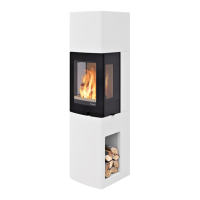Air vent control (FIG 4b)
Forward
Backward
Closed
Open
Removing the self-closing mechanism FIG 41
The self closing door mechanism connected to the
stove at the bottom left corner.
Carefully unhook the spring A and remove the small
screw holding the arm B with 5 mm Allen key.
The self closing mechanism is now deactivated.
Attention! In some countries removing the self
closing mechanism is not allowed. Make sure you
follow the local rules and regulations regarding self
closing doors.
6. Lighting the re for the rst time
When the replace is assembled and all instructions
have been observed, a re can be lit.
Take care when inserting logs into the burn chamber,
in order not to damage the Thermotte plates. Please
note that there might be some humidity in the insulation
plates which can result in a slower burn rate the rst
few times the replace is used. This will be resolved
once the humidity has evaporated. Possibly leave the
door slightly open the rst 2-3 times that the replace
is used. It is advisable to ventilate the room well
when ring for the rst time as the varnish on
the replace may release some smoke or smell.
Both the smoke and smell will disappear and are not
hazardous.
Warning!
In order to avoid injuries, please be aware that the
surfaface may become hot during operation and that
extra care need to be taken to avoid skin burn.
Lighting a re
Insert small dry pieces of kindling wood, ignite and
ensure that the ames have established on the wood
before closing the door. Open the air vent control
(FIG 4) before the door is closed. Additional ignition
air is obtained by keeping the door slightly ajar. The
air supply is regulated with the air vent control once
the ames are stable and the chimney is warm. New
wood logs can be inserted when there is a glowing
layer of ember . Pull the hot ember to the front of the
combustion chamber when inserting new logs so that
the wood is ignited from the front. Leave the door
slightly ajar each time new logs are inserted so that the
ames get well established. The re should burn with
bright and lively ames.
Burning at very a low combustion output and attempting
to burn all day and night increase pollution as well as
the risk of chimney re. Never allow the replace or
ue to become glowing red. Turn off the air vent control
should this happen. Regulation of the air vent control
takes some experience, but after a little while you will
nd a natural combustion rhythm.
Warning!
The Firebox shall to be always closed except
during ignition, refueling and ash removal.
When the draught in the chimney is low and
the vents are closed, the gas from the rewood
can be ignited with a bang. This can cause
damages to the product as well as the immediate
environment.
7. Maintenance
Cleaning and inspection
The replace should be inspected thoroughly and
cleaned at least once per season (possibly in
combination with the sweeping of the chimney and
chimney pipes).
The inspection shall be performed by the Professional
servicemen.
Ensure that all joints are tight and that the gaskets are
rightly positioned. Exchange any gaskets that are worn
or deformed.
Remember that the replace must always be cold when
inspected.
Ashes
The ashes should be removed regularly. Be aware
that the ashes can contain hot ember even several
days after the re has nished. Use a container of
non-combustible material to remove the ashes. It is
recommended to leave a layer of ashes in the bottom
as this further insulates the burn chamber. Take care
with the Thermotte plates when the ashes are removed,
particularly when using an ash shovel, so as not to
damage them.
IMPORTANT! Always remember to open the air
vent control and the door when new wood logs are
inserted into a hot burn chamber. Let the ames get
established on the wood before the air supply is
reduced.
A = ignition air vent

